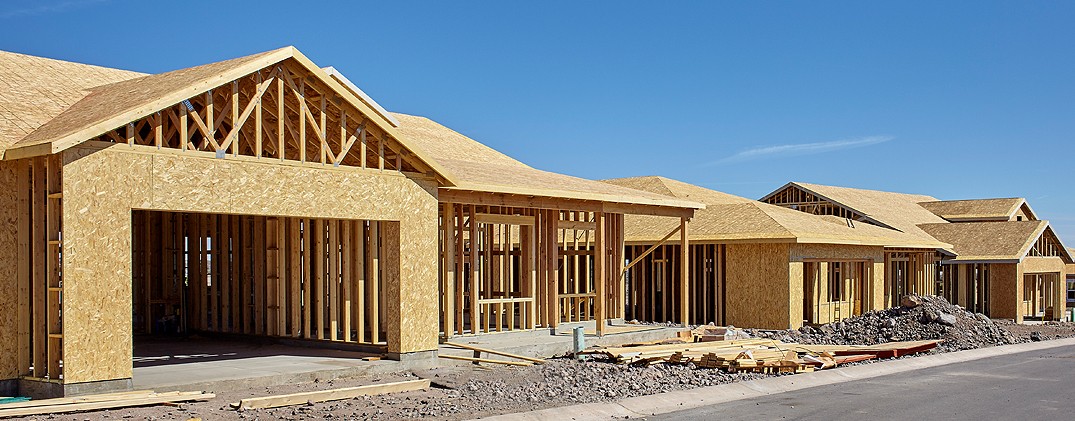
If you plan on purchasing a new construction property in 2024, it would be wise to consider adding a cost segregation study to your overall plan. It’s an important element that allows for a tremendous tax-saving opportunity that’s often overlooked – the chance to greatly accelerate depreciation deductions on land improvements and personal property early on in the game. Whether you perform a cost segregation analysis on a single-family home, duplex, or another type of rental property, you’ll literally save yourself thousands of dollars in the process. With that said, before we dive into this article, let’s take a look at a summary of the question we’ll be addressing:
What is a new construction cost segregation study? A cost segregation study is an analysis and reclassification of the non-structural components of a property where items such as cabinets, sinks, patios, and similar, are placed into accelerated tax depreciation time frames of 5, 7, and 15 years, instead of lumping them in with the building structure as a whole that has a depreciation time frame of 27.5 years for residential real estate.
Ok, now let’s dissect the topic to get a full understanding of what a cost segregation is and how you can benefit from it.
New Construction Cost Segregation Study Explained
A new construction cost segregation study is a thorough analysis of the non-structural elements that make up a property for the sole purpose of reclassifying these eligible items into different tax classifications. Simply put, this pulls the eligible assets out of a “real property – section 1250” tax classification, which depreciates over the entire lifetime of the property, and instead places them into “personal property/land improvements – section 1245” with new accelerated depreciation time frames.

This can save investors a substantial amount of money on their taxes, as confirmed by many seasoned real estate professionals:
“Doing a cost segregation is one of the most powerful tools an investor has at his/her disposal. The tax savings are phenomenal. Yet another reason that real estate is one of the best ways to build wealth.” ― Clayton Morris, Founder & President, Morris Invest
Reclassification of Property Assets Allows for faster Depreciation Rates
These newly assigned items are depreciated over a shorter tax life – 5, 7, 15 years, instead of being grouped into only one real property depreciation time frame of the entire life of the property – 27 1/2 years. This, therefore, significantly accelerates depreciation on these eligible items, which, in turn, greatly decreases your tax burden and increases your cash flow in the earlier life of the investment.
As you can see, performing a cost segregation study on new residential construction projects is certainly a smart real estate tax strategy that prevents your money from being tied up into one property. It allows for the flexibility to allocate your funds to other real estate investments so you can quickly grow your portfolio. If your portfolio is already growing, and you need reliable rental property insurance to maximize your cash flow, take a look at National Real Estate Insurance Group; we recommend them to all our clients.
How are Items Broken Out into Accelerated Depreciation Time Frames?
A cost segregation engineer will do a thorough analysis to determine which real estate property items are eligible for accelerated depreciation. This comes down to assigning components into three classifications. Let’s take a look at each one to better understand where new construction property elements may fall into place:
-
Building Components/Personal: This includes certain items that are brought into, installed, or applied to the residential property that are separate from the building’s structure. Kitchen cabinets are one example of a building component.
-
Site Work/Land Improvements: Site work includes improvements to the area where the structure will stand. However, it would be before the foundation is applied and before going vertical. This might include soil removal or grading. Site work/land improvements also include work done to the area surrounding the immediate construction site. Laying down a driveway is a perfect example of land improvements.
-
Building Structure: This would be the building and its structural components, such as its foundation.

Let’s break it down a bit further with some additional examples of items that coincide with each new construction cost segregation category, along with their depreciation time frames.
-
(5-Year) Building Components: Molding, Flooring/Carpet, Ceiling Fans, Wall Coverings, Window Treatments, Specialty Plumbing for Kitchen Sinks and Washer Hook-Ups, Security, Appliances
-
(15-Year) Site Work/Land Improvements: Driveway, Landscaping and Irrigation, Exterior Fencing, Patio/Porch Concrete
-
(27 1/2-Years) Building Structure: Foundation, HVAC, Electrical, Plumbing, Fire Protection and Alarms, Exterior Facade/Building Skins, Doors, Frames, Windows
The Benefits of Performing a New Construction Cost Segregation Analysis
Investors really can’t afford not to perform a cost segregation analysis, especially those who purchase single-family homes and duplexes used as rental properties. A professional cost segregation analysis on residential properties can significantly reduce the amount paid to the IRS in the first year, and the years that follow. To learn more about lowering your taxes as much as possible, you may want to read an outstanding book by Tom Wheelwright that you can easily pick up on Amazon: Tax-Free Wealth.
Take a look at a summary of benefits of cost segregation studies:
-
Cost segregation studies performed on the new construction of single-family homes and duplexes can increase your tax savings by adjusting and accelerating the time frames of deductions. This can save you incredible amounts of money and free up capital to invest as you see fit.
-
You’ll still continue to depreciate items over the lifetime of the residential property – 27 1/2 years. However, because a certain percentage of these elements are reclassified, and you’re accelerating them in the first year, that means you’re giving the IRS less of your money on an annual basis.
-
Reclassification of property assets within a new construction project allows you to benefit financially from new land improvements that typically can’t be written off on existing rental property purchases or renovations.
-
This tax strategy creates an audit trail that supplies you with the necessary documents for costs and classifications in the event they are ever needed.
Watch this video to get a general overview of how a new construction cost segregation study works:
Should I Perform a Single or Multi-Family Home Cost Segregation Study Myself?
The money you save from having a cost segregation performed on your new rental property will far outweigh the fees associated with hiring an expert. Plus, there may be an option of having the analysis cost built into the new construction price, normally at a reduced rate or possibly free of charge. Having an expert in the field perform the cost segregation study will ensure that it’s well-documented and correct, as well as done in such a way that will maximize your tax savings.
Here are a few reasons why an engineer should do your new construction cost segregation study for you:
-
Allows for a professional and accurate assessment of classification and cost estimating of new construction projects, which will maximize your tax savings.
-
Experienced cost segregation specialists will have the ability to read blueprints, analyze architectural drawings, bid documents, and handle other crucial elements that play a part in the analysis.
-
Cost segregation studies are performed by a construction engineer with extensive knowledge of the tax law.
-
Provides asset classification organization, along with explanations, if needed – no research or guessing on your part.
Sample New Construction Cost Segregation Tax Savings on a Single-Family Rental Property
If you had $100,000 in cash that’s not invested, and you happen to pay a 37% tax rate on it, you would have to pay $37,000 in taxes to the government. In contrast, if you invested this $100,000 as a down payment on the new construction of a single-family home rental property, and performed a cost segregation study, the amount you would owe to the IRS would be considerably reduced based on the following example.
Purchase Price: $400,000
Down Payment: $100,000
Cost Segregation Write-Off: $70,000
Multiply the $70,000 cost segregation write-off by the same 37% tax bracket, and you have a $25,900 savings. This means you would only owe $11,100 to the government that first year.
Take that savings of $25,900 and add it to a $6,000 cash flow for the year, and you now have a $31,900 return on investment. This equates to a 31.9% first-year return on your $100,000 investment!
As you can see, utilizing a new construction cost segregation study will greatly impact your bottom line. To further decrease your taxes, it’s recommended that you incorporate your real estate business. We recommend reaching out to Corporate Direct for help with this. I’ve personally used Corporate Direct and recommend them to all my clients.
Questions & Answers Related to Cost Segregation Studies
Cost segregations seem to be a secret that many investors have no knowledge of. Because of this, we receive many questions from interested clients on the ins and outs of this tax-saving strategy. Below, you’ll find a few of our most popular questions.
1. Can I apply a new construction cost segregation to a primary residence?
When it comes to tax strategies, a personal home will have a whole other set of rules compared to an investment property. This includes the fact that a house utilized as a full-time residence is not permitted to have a cost segregation applied. The bottom line is that the IRS states that you’re not allowed to claim depreciation on property held for personal purposes because depreciation only applies to income-earning assets.
2. Is a cost segregation study worth it if I only have one rental property?
Speaking with an engineer who specializes in this sector can give you a definitive answer based on your specific situation, but generally, a new construction cost segregation analysis may not be beneficial if you only have one property. This is the case because you’re going to spend thousands to have the study completed by a professional, and this may offset the money you would save on your taxes through the study.

Investors who build new properties in bulk, 20 to 50, or more, are the ones who benefit from this tax-reducing strategy the most. However, you can use a cost segregation study to your advantage when owning one property if that piece of real estate is purchased from a full-service real estate company that provides a cost segregation with the purchase. Morris Invest includes this for free to their clients who qualify, which saves their clients thousands of dollars because they won’t have to hire an engineer to perform the study; it’s already completed.
3. How often should I have a cost segregation analysis performed?
When purchasing a new property for investment purposes, only one cost segregation study is needed. However, if major improvements or large renovations are made later down the line, a second study may be advised. This would include improvements such as a building expansion – adding a bedroom or a second floor to the home, and the like.
Morris Invest Offers New Construction Rental Properties with a Built-In Cost Segregation Analysis
Now that you see the power of cost segregation when it comes to greatly accelerating certain aspects of a new construction property, you may want to consider integrating an analysis into your next real estate project. With this in mind, the most effective route to take would be to have your cost segregation study built right into your construction project.
“Most people don’t realize how much time and money it takes to perform a cost segregation study. Our clients are usually shocked to learn that we’ve already paid for and already completed the cost segregation when they buy one of our properties.” ― Clayton Morris
Morris Invest offers a professional full-service experience where everything from the rental property construction to the cost segregation analysis is handled for you. We even place a tenant and a property manager so you won’t have to. Below, you will find a few details on what our team offers our clients when it comes to a cost segregation.
-
Our professional team of residential real estate, construction, and engineering experts build the cost segregation studies directly into our new construction projects – creating a hassle-free investment experience for the client.
-
A new construction cost segregation study on a single-family home or duplex can take up to three months or longer. However, because an analysis goes hand-in-hand with our real estate projects when a property is purchased, the study is already performed before the keys are handed over to our client. This allows the investor to accelerate their depreciation at a much faster rate, maximizing their tax savings.
-
Our focus is on single-family residential rental properties and duplexes, making us experienced industry leaders.
Book a call with Morris Invest if you would like more information on our new construction rental properties or cost segregations in general. And if you’re on the fence about investing in a rental property, we suggest that you dive into our latest article – New Construction Build-to-Rent Properties are a Good Investment with a Skyrocketing Demand.
Additional Real Estate Articles by Morris Invest
You can always benefit from increasing your knowledge base if you’re new to the game or a seasoned investor. With that said, be sure to check out the resources below:
- Rental Properties are a Safe Investment in Times of High Inflation
- Lubbock Rentals Remain Strong Throughout Pandemic
- Find Out How Equity is Used in Real Estate Investing
- View these Tips on Increasing Cash Flow with the BRRRR Method
- Dive into this Article on Turnkey Properties
- Learn Why Texas Real Estate is So Affordable
- Find Out How to Buy Properties with Multiple Investors
- Utilize the BRRRR Method and Quickly Grow Your Portfolio
- Read the Investing Differences Between Stocks and Real Estate
- Learn about Estate Planning with Details on Rental Properties
- Find Out Why a New Construction Cost Segregation Study is Worth it
- Here are a Few Tips for Foreign Investors who Buy US Real Estate
Also, take a look at our post on real estate investing tools to get ahead of the game, as well as this article we wrote on using your self-directed IRA funds to invest in real estate. You’ll also want to head over to our article that’s related to new construction – Rental Real Estate Trends: Increased Demand & New Construction Property Boom.
Take Control of Your Money in 2024 with a New Construction Cost Segregation Study
Wise real estate investors utilize the power of a cost segregation study to reclassify their new construction assets. They do this knowing that it’s an incredible tax strategy that saves them thousands of dollars in the early life of the property. It also gives them the freedom to allocate those funds towards other real estate investments if they see fit. The alternative is not doing a study and sending thousands of dollars to the government. Taking advantage of all a cost segregation has to offer just makes sense, doesn’t it?
Book a quick call and let Morris Invest help you with all the details of a new rental property construction project and built-in cost segregation study.
Listen to our “Understanding Cost Segregation – Interview with David Brizel” podcast if you’re interested in learning more about this topic.
Before you leave, have a look at our Cost Segregation Tax Hacks: Investing for Beginners video:
Ready To Build Passive Income Through Rental Real Estate?
Ready to talk about your goals? We're here to show you the tools and teach you the process to begin earning legacy wealth for you and your family.








